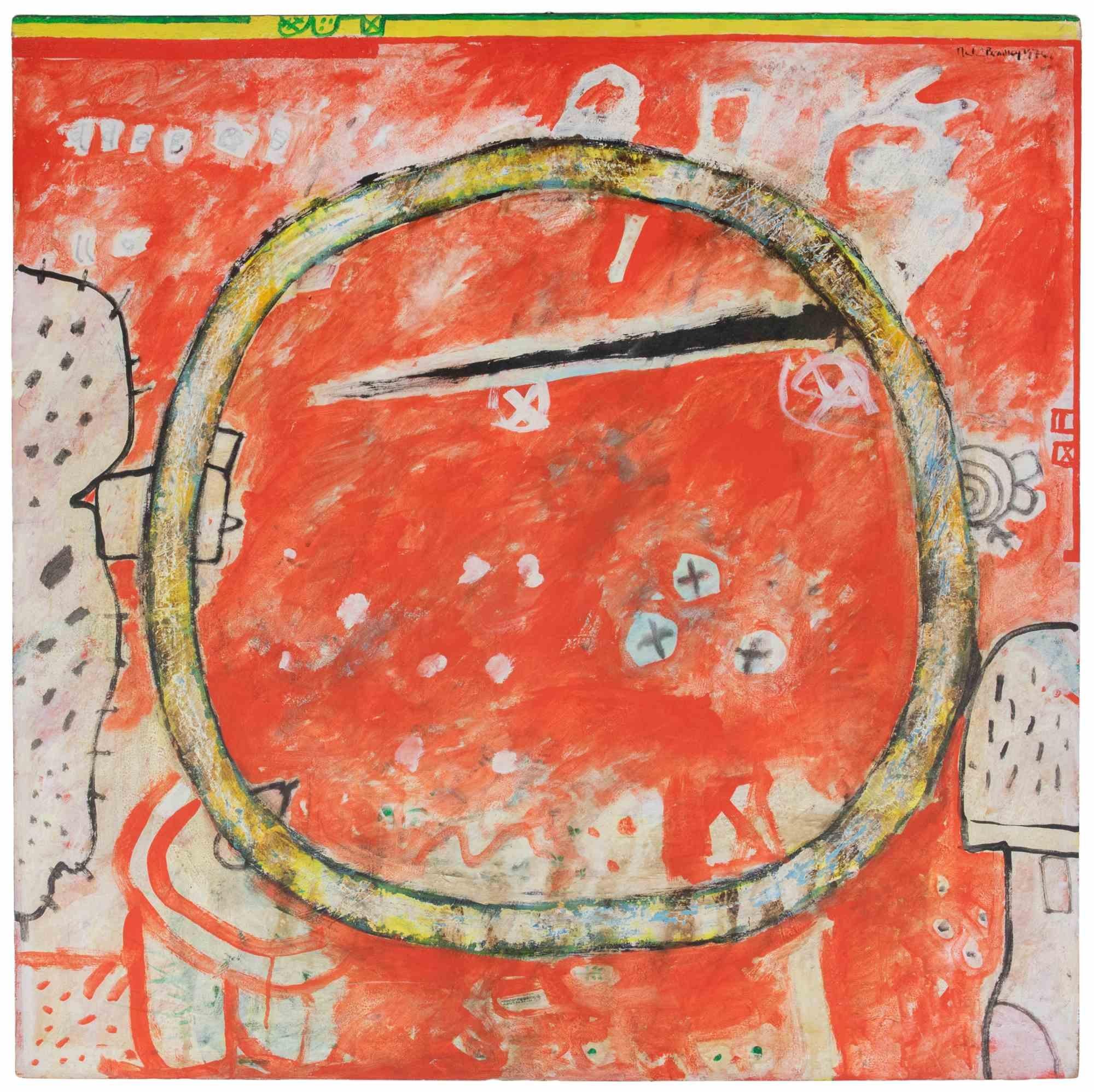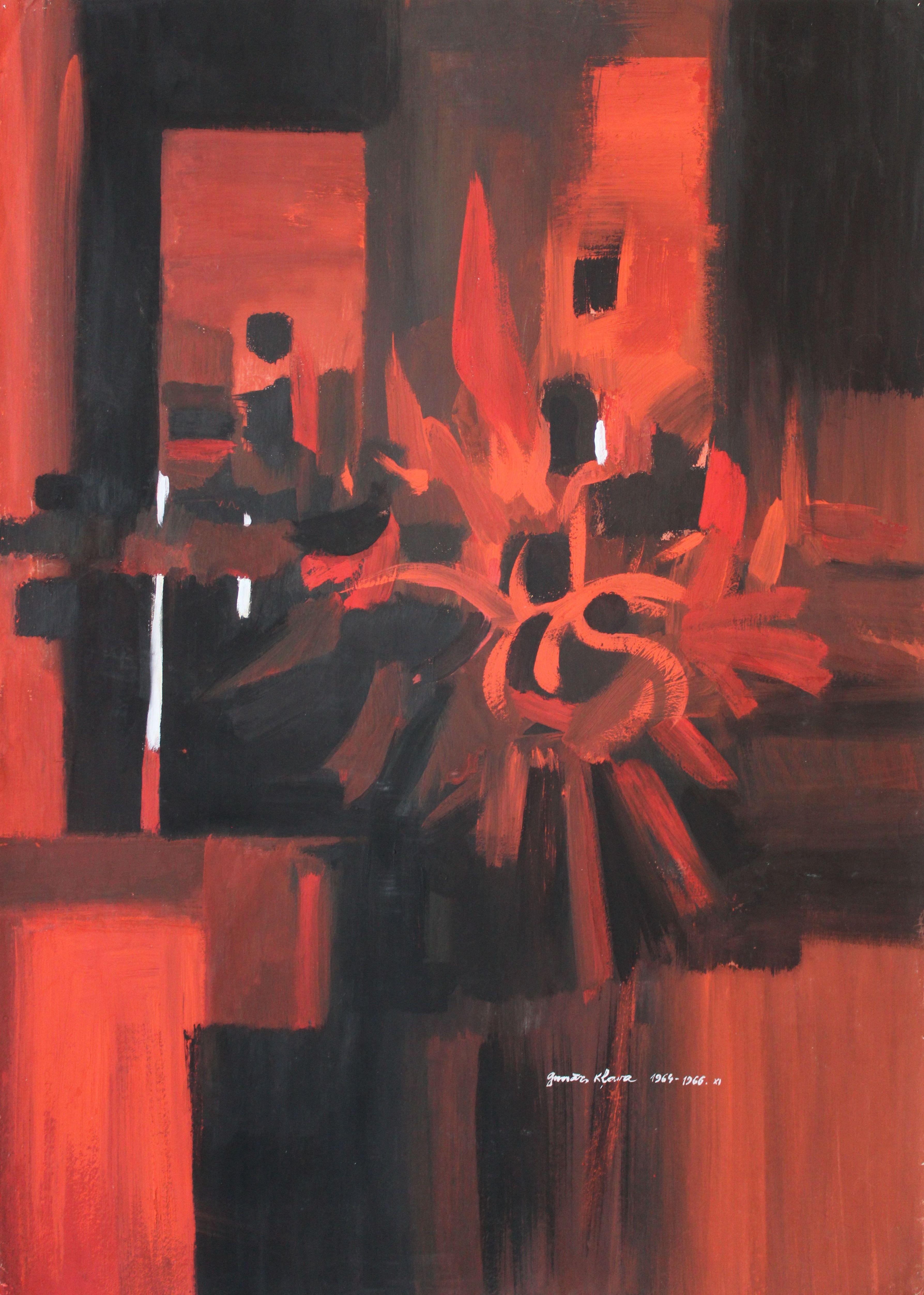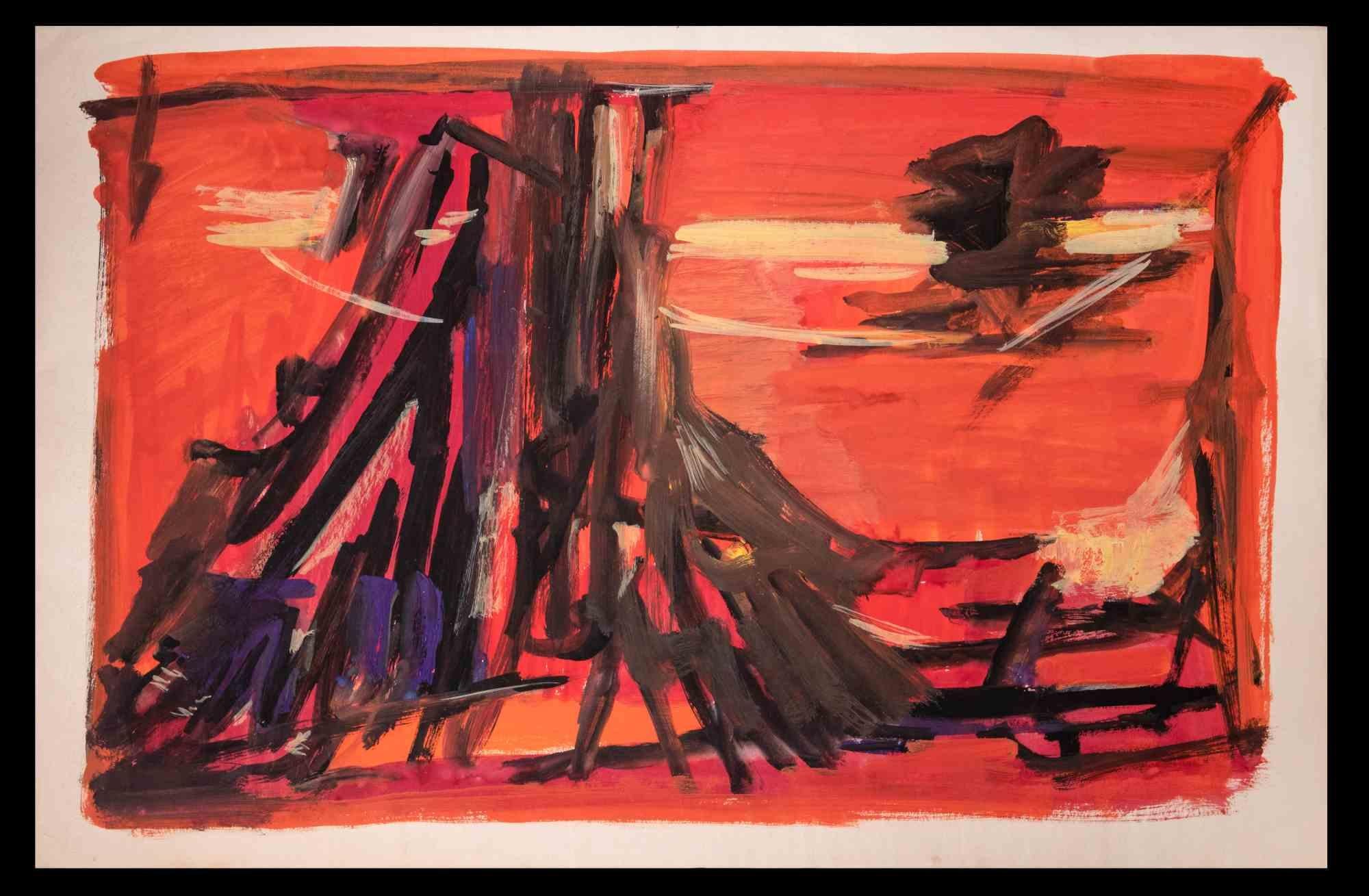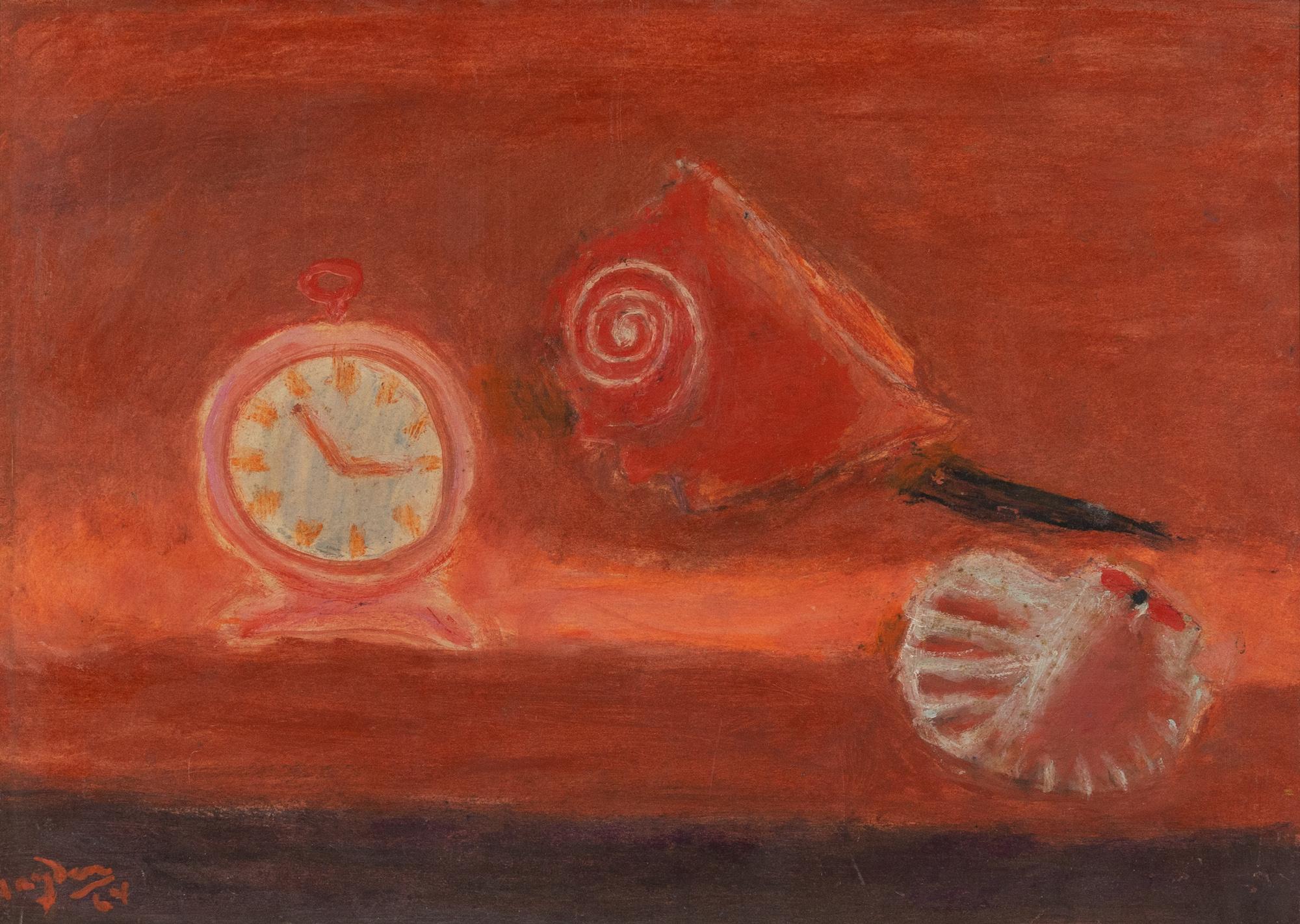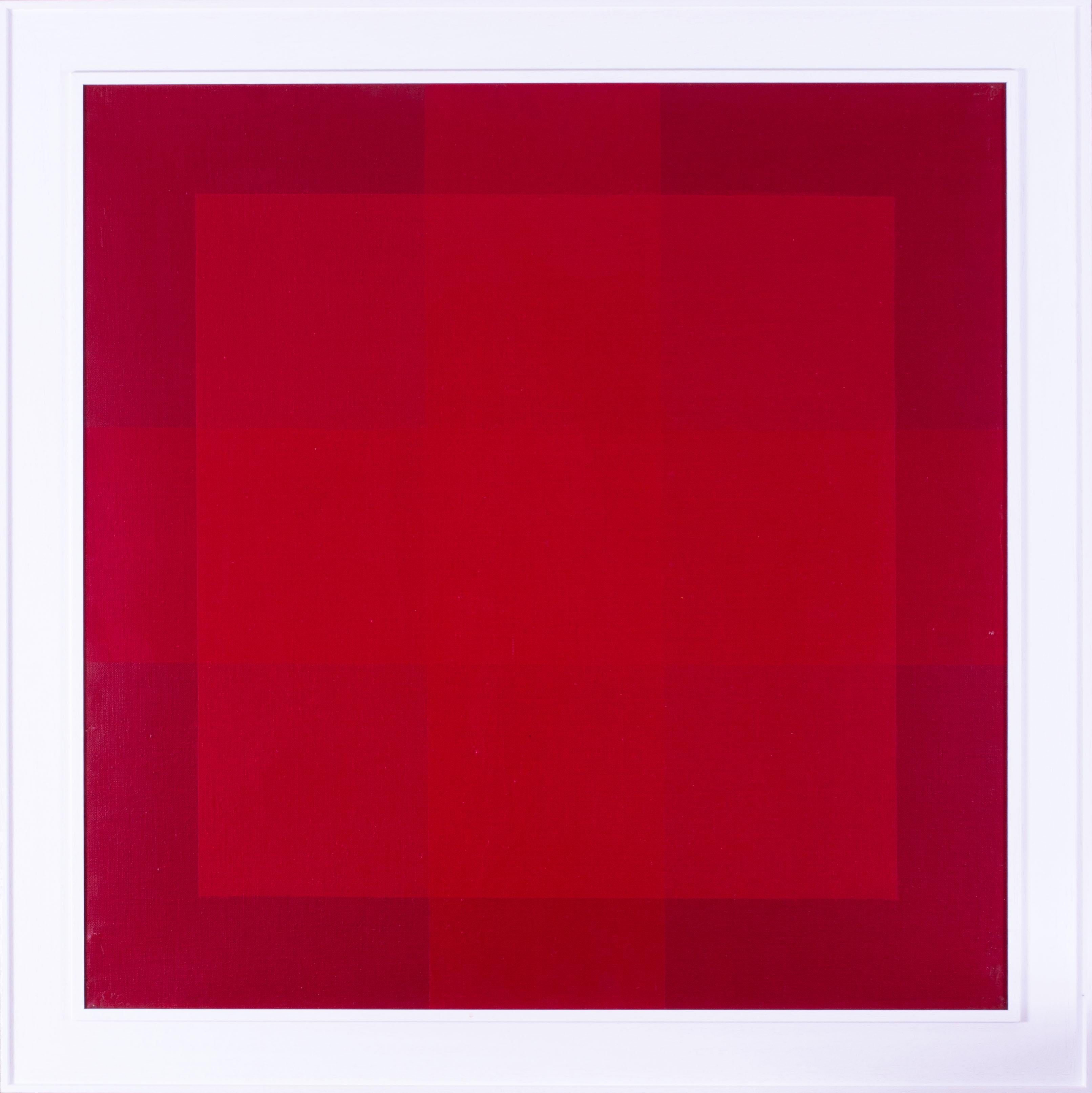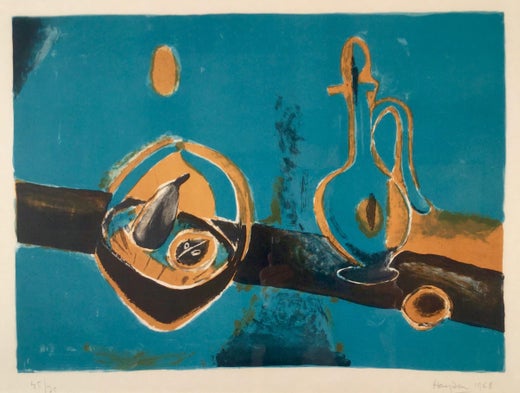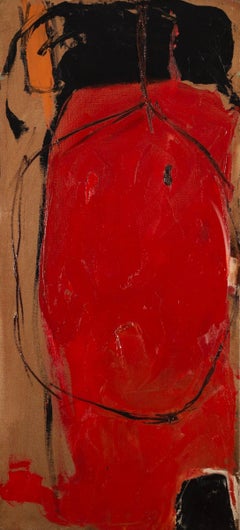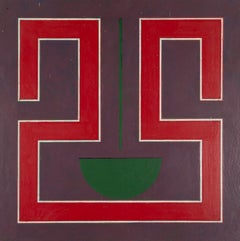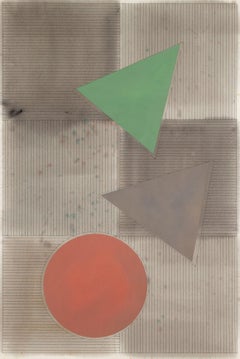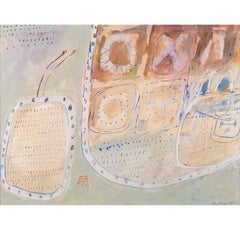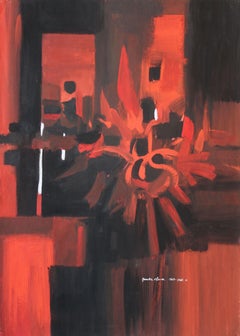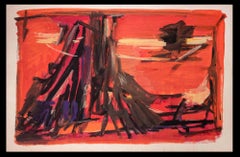Items Similar to Étude en rouge, Gouache Painting by Henri Hayden, 1964
Want more images or videos?
Request additional images or videos from the seller
1 of 6
Henri HaydenÉtude en rouge, Gouache Painting by Henri Hayden, 19641964
1964
Price Upon Request
Price Upon Request
Price Upon Request
Price Upon Request
Price Upon Request
Price Upon Request
Price Upon Request
Price Upon Request
Price Upon Request
Price Upon Request
About the Item
Étude en rouge, Gouache Painting by Henri Hayden 1883-1970, 1964
Additional information:
Medium: Gouache
50 x 50 cm
19 3/4 x 19 3/4 in
Signed and dated
Henri Hayden was a School of Paris painter, mainly of still life and landscape.
Hayden was born in Warsaw and studied engineering at Warsaw Polytechnic from 1902. Alongside this he studied painting at the Ecole des Beaux-Arts and, in 1905, decided to devote himself entirely to painting.
Hayden moved to Paris in 1907, then a hotbed for the European artists of his generation, and briefly studied at the art school La Palette. He travelled to Brittany most summers from 1909-18 to paint in its unique light, including Le Pouldu and Pont Aven. His first solo exhibition was at the Galerie Druet, Paris, in 1911. He was influenced by Cézanne, whose groundbreaking retrospective had been shown in the city the same year Hayden had arrived, and decided to join the Cubist movement (1915-21) where he became friends with the small circle including Braque, Gris, Lipchitz and Picasso. In 1916 the exclusive Cubist dealer, Leonce Rosenberg, brought Hayden under contract.
Becoming tired with the movement in 1922, Hayden reacted against Cubism and returned to the direct study of nature. He continued to exhibit in France, including a number of solo shows. During the German Occupation, Hayden took refuge in the South of France and, on returning to Paris in 1944, found his studio and much of his work destroyed by the Nazis.
Hayden bought a country house in 1962, near La Ferté-sous-Jouarre, and immersed himself in area, using its landscape views and places as the subjects for his paintings. For many years, Hayden was represented in London by Waddington Galleries. His works are in the collections of Musee d'Art Moderne, Paris; Petit Palais, Paris; Stockholm Museum; Budapest Musem; Barnes Foundation, Philadelphia.
- Creator:Henri Hayden (1883 - 1970, Polish)
- Creation Year:1964
- Dimensions:Height: 19.75 in (50.17 cm)Width: 19.75 in (50.17 cm)
- Medium:
- Period:
- Condition:
- Gallery Location:Kingsclere, GB
- Reference Number:1stDibs: LU2718214574182
Henri Hayden
Henri Hayden was a School of Paris painter, mainly of still life and landscape. Hayden was born in Warsaw and studied engineering at Warsaw Polytechnic from 1902. Alongside this he studied painting at the Ecole des Beaux-Arts and, in 1905, decided to devote himself entirely to painting. Hayden moved to Paris in 1907, then a hotbed for the European artists of his generation, and briefly studied at the art school La Palette. He travelled to Brittany most summers from 1909-18 to paint in its unique light, including Le Pouldu and Pont Aven. His first solo exhibition was at the Galerie Druet, Paris, in 1911. He was influenced by Cézanne, whose groundbreaking retrospective had been shown in the city the same year Hayden had arrived, and decided to join the Cubist movement (1915-21) where he became friends with the small circle including Braque, Gris, Lipchitz and Picasso. In 1916 the exclusive Cubist dealer, Leonce Rosenberg, brought Hayden under contract. Becoming tired with the movement in 1922, Hayden reacted against Cubism and returned to the direct study of nature. He continued to exhibit in France, including a number of solo shows. During the German Occupation, Hayden took refuge in the South of France and, on returning to Paris in 1944, found his studio and much of his work destroyed by the Nazis. Hayden bought a country house in 1962, near La Ferté-sous-Jouarre, and immersed himself in area, using its landscape views and places as the subjects for his paintings. For many years, Hayden was represented in London by Waddington Galleries. His works are in the collections of Musee d'Art Moderne, Paris; Petit Palais, Paris; Stockholm Museum; Budapest Musem; Barnes Foundation, Philadelphia.
About the Seller
No Reviews Yet
Vetted Professional Seller
Every seller passes strict standards for authenticity and reliability
Established in 2010
1stDibs seller since 2024
41 sales on 1stDibs
Typical response time: 7 hours
- ShippingRetrieving quote...Shipping from: Kingsclere, United Kingdom
- Return Policy
Authenticity Guarantee
In the unlikely event there’s an issue with an item’s authenticity, contact us within 1 year for a full refund. DetailsMoney-Back Guarantee
If your item is not as described, is damaged in transit, or does not arrive, contact us within 7 days for a full refund. Details24-Hour Cancellation
You have a 24-hour grace period in which to reconsider your purchase, with no questions asked.Vetted Professional Sellers
Our world-class sellers must adhere to strict standards for service and quality, maintaining the integrity of our listings.Price-Match Guarantee
If you find that a seller listed the same item for a lower price elsewhere, we’ll match it.Trusted Global Delivery
Our best-in-class carrier network provides specialized shipping options worldwide, including custom delivery.More From This Seller
View AllRed Net, Oil on Canvas by Douglas Swan, 1959
By Douglas Litterick Swan
Located in Kingsclere, GB
Red Net, Oil on Canvas by Douglas Swan, 1959
Additional information:
Medium: Oil on Canvas
105 x 48 cm
41 3/8 x 18 7/8 in
Signed, titled and dated vers...
Category
20th Century Abstract Paintings
Materials
Canvas
Price Upon Request
Red Forms with Small Green Segment - Bold 1960s Abstract Oil Painting, Sixties
By Gordon House
Located in Kingsclere, GB
Gordon House was born in 1932 in Pontardawe, South Wales. Early exposure to art on trips to the Glynn Vivian Art Gallery as a young boy inspired House towards creative endeavors and at the age of fourteen he was awarded a grant to enter art school which he accepted. From 1947 to 1950 he studied at Luton School of Art, Bedfordshire, and St. Albans School of Art, Hertfordshire. House's contemporaries included Richard Smith and John Plumb with whom he remained close. During the early fifties, after finishing art school, House began work as assistant to the ecclesiastical sculptor Theodore Kern. He also spent time at an advertising studio where he honed his burgeoning skills in typography and graphic design. In 1952 House was offered the position of designer for Imperial Chemical Industries Plastics Division where he stayed until 1959. This was followed by two years spent as graphic designer for the Kynoch Press in London. In 1961 House set out on his own as a self-employed designer and typographer. Initially this was supplemented by part-time teaching at art schools in and around London but by 1964 House was able to devote himself entirely to his design work which freed up valuable time to concentrate on his own artistic output in the studio.
In the late fifties, informed by the new art emerging from America and that of his contemporaries in England, House began to create large-scale abstract works which he was invited to show in 1959 at Dennis Bowen's legendary New Vision Centre in Marble Arch.
House was an active participant in the vibrant London art scene of the sixties, regularly attending lectures, exhibitions and discussions. In 1960 he exhibited in 'Situation' the key abstract exhibition of the decade held at the RBA Galleries. Other participating artists included Robyn Denny, Bernard and Harold Cohen, Gillian Ayres, John Hoyland, Richard Smith and William Turnbull among others. These artists, united by a common admiration for American Abstract Expressionism, were frustrated by the lack of exposure given to large-scale abstract works in commercial galleries so they organised their own exhibition. The name was derived from the participants' idea that an abstract painting that occupied the whole field of vision would involve the spectator in an 'event' or 'situation'. This exhibition was followed by 'New London Situation' in 1961 and a nationwide touring Arts Council presentation in recognition of the significance of the two earlier shows.
In 1961 House began producing his first prints at the Kelpra Studio, run by Chris and Rose Prater, where he made the earliest fine art screenprint ever to be produced in Britain. Artists such as Paolozzi and Hamilton followed in his footsteps and together they started a printmaking revolution in Britain. They cemented the medium of the screenprint in the world of fine art as opposed to the commercial sphere and secured the reputation of Kelpra in the process. Later, together with Cliff White, House set up the White Ink (Ltd.) print studio in London, where he produced etchings and wood engravings on a series of magnificent antique printing presses...
Category
20th Century Abstract Paintings
Materials
Oil, Board
Red/Green, from Study for Larger Tri Motif Series, 1977 - Gouache, Watercolour
By Gordon House
Located in Kingsclere, GB
Gordon House was born in 1932 in Pontardawe, South Wales. Early exposure to art on trips to the Glynn Vivian Art Gallery as a young boy inspired House towards creative endeavors and at the age of fourteen he was awarded a grant to enter art school which he accepted. From 1947 to 1950 he studied at Luton School of Art, Bedfordshire, and St. Albans School of Art, Hertfordshire. House's contemporaries included Richard Smith and John Plumb with whom he remained close. During the early fifties, after finishing art school, House began work as assistant to the ecclesiastical sculptor Theodore Kern. He also spent time at an advertising studio where he honed his burgeoning skills in typography and graphic design. In 1952 House was offered the position of designer for Imperial Chemical Industries Plastics Division where he stayed until 1959. This was followed by two years spent as graphic designer for the Kynoch Press in London. In 1961 House set out on his own as a self-employed designer and typographer. Initially this was supplemented by part-time teaching at art schools in and around London but by 1964 House was able to devote himself entirely to his design work which freed up valuable time to concentrate on his own artistic output in the studio.
In the late fifties, informed by the new art emerging from America and that of his contemporaries in England, House began to create large-scale abstract works which he was invited to show in 1959 at Dennis Bowen's legendary New Vision Centre in Marble Arch.
House was an active participant in the vibrant London art scene of the sixties, regularly attending lectures, exhibitions and discussions. In 1960 he exhibited in 'Situation' the key abstract exhibition of the decade held at the RBA Galleries. Other participating artists included Robyn Denny, Bernard and Harold Cohen, Gillian Ayres, John Hoyland, Richard Smith and William Turnbull among others. These artists, united by a common admiration for American Abstract Expressionism, were frustrated by the lack of exposure given to large-scale abstract works in commercial galleries so they organised their own exhibition. The name was derived from the participants' idea that an abstract painting that occupied the whole field of vision would involve the spectator in an 'event' or 'situation'. This exhibition was followed by 'New London Situation' in 1961 and a nationwide touring Arts Council presentation in recognition of the significance of the two earlier shows.
In 1961 House began producing his first prints at the Kelpra Studio, run by Chris and Rose Prater, where he made the earliest fine art screenprint ever to be produced in Britain. Artists such as Paolozzi and Hamilton followed in his footsteps and together they started a printmaking revolution in Britain. They cemented the medium of the screenprint in the world of fine art as opposed to the commercial sphere and secured the reputation of Kelpra in the process. Later, together with Cliff White, House set up the White Ink (Ltd.) print studio in London, where he produced etchings and wood engravings on a series of magnificent antique printing presses...
Category
20th Century Abstract Paintings
Materials
Ink, Watercolor, Gouache
Untitled, Gouache & Watercolour on Paper Painting by Martin Bradley, 1962
By Martin Bradley
Located in Kingsclere, GB
Untitled, Gouache & Watercolour on Paper Painting by Martin Bradley, 1962
Additional information:
Medium: Gouache and watercolour on paper
65.3 x 88.9 cm
25 3/4 x 35 in
Martin Brad...
Category
20th Century Abstract Drawings and Watercolors
Materials
Watercolor
Untitled, circa 2001 - Abstract Oil Painting over Paper Collage
By Gordon House
Located in Kingsclere, GB
Gordon House was born in 1932 in Pontardawe, South Wales. Early exposure to art on trips to the Glynn Vivian Art Gallery as a young boy inspired House towards creative endeavors and ...
Category
Early 2000s Paintings
Materials
Canvas, Oil, Magazine Paper
Still Life, Red & Yellow Flowers, Gouache Painting by Peter Potworowski, c 1955
Located in Kingsclere, GB
Still Life, Red & Yellow Flowers, Gouache Painting by Peter Potworowski, c 1955
Additional information:
Medium: Gouache
23.6 x 33.3 cm
9 1/4 x 13 1/8 in
Tadeusz Piotr (Peter) Potworowski was a Polish abstract and figurative painter who lived and exhibited in Paris, Poland, Sweden and England.
Potworowski was born in Warsaw in 1898. After serving in the First World War, Potworowski enrolled at the Warsaw University of Technology to study architecture, though his studies were halted by the Bolshevik campaign. After the end of the Polish-Soviet War in 1921, Potworowski returned to Warsaw and began to study art at the school of Konrad Krzyżanowski. By the following year, he had taken a place at the Academy of Fine Arts in Krakow, where he studied under Józef Pankiewicz. It was Pankiewicz who incorporated Potworowski into the Paris Commute, or Kapists, a group of Polish artists who travelled to the French capital in 1924.
During his seven years in Paris he became personally acquainted with Pablo Picasso, Pierre Bonnard, Jean Cocteau, Constantin Brancusi and attended for a short time Fernand Léger's studio. It was through this job that he met his first wife Magdalena Mańkowska, a student of anthropology in Paris. After marrying in France, and visiting Britain in 1928, the couple returned to Poland in 1930, where their first son John was born.
In 1931, Warsaw was the locale of the first Kapists exhibition, entitled New Generation, which took place at the Artist's Club, Hotel Polonia, and the Institute of Art Propaganda. Here, Potworowski received a prize for his painting Three Women in the Interior. The following year, he held his first solo exhibition at the Makowski Salon in Poznań. This success was sustained through 1937 when the artist received a silver medal at the International Exhibition of Art and Technology in Paris, as well as the award from the Minister of Foreign Affairs. After this strong development, Potworowski had a travelling solo exhibition arranged, held in 1938 at the Institute of Propaganda of Art in Warsaw and then in Lviv.
Following the invasion of Poland in 1939, Potworowski escaped to Sweden via Lithuania. It was from here that the artist, with his wife and two young children, made his way to Britain, arriving in 1943. After serving in Scotland, Potworowski settled in London, and in January 1946, an exhibition of 33 of his works was held at the Redfern Gallery. This was followed by regular exhibitions with the Redfern, Gimpel Fils (1948 onwards) and The London Group, to which he was elected a member in 1949. He was also the president of the Association of Polish Artists and published regularly in the monthly magazine "Nowa Polska".
Potworowski's teaching career included eight years as Professor of Painting at the Bath Academy of Art, Corsham (1949-57), where he had considerable European influence, specifically on abstraction, and was acknowledged by contemporaries including Peter Lanyon, Bryan Wynter...
Category
20th Century Abstract Paintings
Materials
Gouache
You May Also Like
Red sun. 1969, gouache on paper, 59x70 cm
Located in Riga, LV
Red sun. 1969, gouache on paper, 59x70 cm
Gunars Klava (1933 – 1989)
Gunars Klava was born in 1933 in Priekule.
1953 - graduated from J. Rosenthal Art School
1964 - began to partic...
Category
1960s Abstract Expressionist Abstract Paintings
Materials
Paper, Gouache
Red Image - Oil Paint by Martin Bradley - 1974
By Martin Bradley
Located in Roma, IT
Oil on plywood realized by Martin Bradley in 1974.
Hand signed and dated in top right corner; hand signed and titled on rear.
Very good condition.
Category
1970s Contemporary Abstract Paintings
Materials
Canvas, Oil
Red abstraction. 1964-66, paper, gouache, 86x 61 cm
Located in Riga, LV
Red abstraction
1964-66, paper, gouache, 86x61 cm
Gunars Klava (1933 – 1989)
Gunars Klava was born in 1933 in Priekule.
1953 - graduated from J. Rosenthal Art School
1964 - began...
Category
1960s Abstract Expressionist Abstract Paintings
Materials
Paper, Gouache
Abstract Composition in Red - Paint by Émile Marze - 1970s
Located in Roma, IT
Abstract Composition in Red is a painting in tempera and watercolor on ivory-colored paper, realized in the 1980s by French artist Émile Marze (1930-2009).
Good conditions.
The art...
Category
1980s Abstract Abstract Paintings
Materials
Tempera, Watercolor
Coquillage et réveil en rouge by Henri Hayden - Still Life Painting
By Henri Hayden
Located in London, GB
Coquillage et réveil en rouge by Henri Hayden (1883-1970)
Oil on paper laid down on isorel
33.5 x 46 cm (13 ¹/₄ x 18 ¹/₈ inches)
Signed and dated lower le...
Category
1960s Modern Figurative Paintings
Materials
Masonite, Oil, Laid Paper
Red abstract acrylic on canvas work by mid 20th Century Claire Pichaud
Located in Petworth, West Sussex
Claire Pichaud (French 1935 – 2017)
Red abstract
Acrylic on canvas
Squares and diamond lozenge
Signed ‘Claire Pichaud’ (on the stretcher)
31.1/2 x 31.1/2 in. (80 x 80 cm.)
Further ...
Category
20th Century Abstract Abstract Paintings
Materials
Canvas, Acrylic
